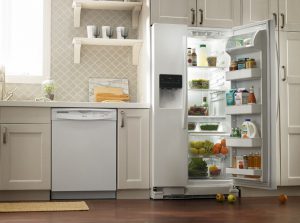Before You Reach for the Sponge
First and foremost, the manual for each of your appliances should not be ignored. Often, there are sections that specify exactly what cleaning tools can be used and, likewise, what tools should be avoided.
For example, a golden rule for anyone to follow — especially in a kitchen with more expensive products — is that stainless steel should never endure scrubbing. Using something abrasive can cause scratches, so it’s best to start with something to gently cut the grease and oils, rather than go at it with steel wool or anything bristled.
Instead of a more aggressive cleaning product, take the moderate route and use a lint-free cloth or microfiber sponge to carefully shine your stainless steel. This rule can be applied even to the new, less shiny colored stainless steel, as well. With a little delicacy, your stainless steel will be able to withstand the long years of messes and spills to come.
Careful with Your Cooktop
There are going to be different ways of cleaning cooktops depending on what you own. If you have an induction cooktop, follow the stainless steel method and only use soft cloths to avoid scratches. Vinegar is a fantastic way to clean up water spots and, in general, it’s best to only use that or glass cleaner and specific ceramic cooktop cleaners on you surface. Save yourself the headache, and skip the bleach.
If you’re sporting a gas cooktop or range top, though, you’re going to have to be a little more intensive. Give quick wipe downs to all your burner tops, grates, and bowls with soapy water, and every so often remove the burner caps for a more thorough clean. Again, avoid the more abrasive tools and intensive cleaning liquids.
Regardless of what kind of cooktop you use, it’s always a good idea to take care of spills on your stove as they happen. Dried splatters are both difficult and vexing to clean up later.
Self-Cleaning Isn’t Totally Self
While most ovens have a self-clean feature, you should put in a little bit of your own elbow grease once in a while. Doing a quick wipe down of your stove before the self-clean process is the way to get the best results. You should also be sure to remove oven racks and wash them by hand in hot, soapy water. For this, if there’s a stubborn amount of grime, you can use a soft scrub cleanser.
If you find stains that are really stubborn, you might want to use a mixture of baking soda and water to clean the interior. Make sure you wear gloves as you clean, and let the mixture sit overnight to be sprayed clean with vinegar in the morning.
Refrigerator Solutions
First things first when cleaning up your fridge: take the food items out, and make sure you have what needs to be refrigerated and what needs to remain frozen in a separate cooler each. Use this time to also make sure you’ve tossed out all expired items, too. Once you’ve done that, you can unplug it and let it defrost.
Luckily, you won’t have to be overtly delicate with the interior shelves and bins of your fridge. Some models even allow you to wash them in the refrigerator, itself. For the drip pan, you can use bleach to clean it once it’s been drained of liquid, and even use your vacuum crevice attachment to clean the condenser coil at the back of the appliance.
While maintaining your kitchen may require a more attentive touch, it’s not an impossible or difficult feat. Whether it’s an oven, a stovetop, or a refrigerator, keeping it looking great only requires a little bit of work — and you’ll be rewarded with a lot of use out of those appliances for the future.
And, should the maintenance be more than you can handle, don’t be afraid to contact a professional repair service.
